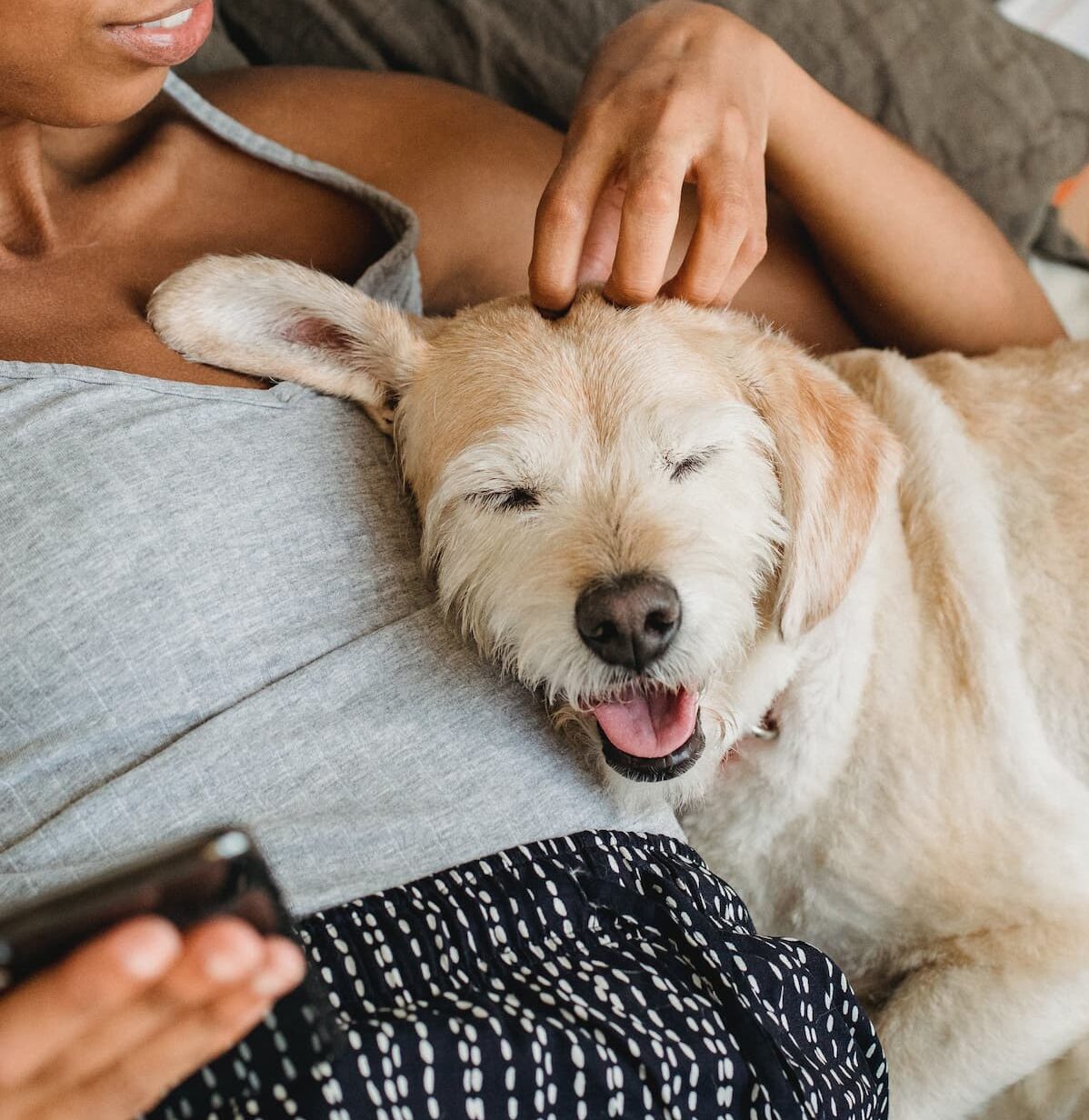Wondering why your furry companion suddenly starts twitching?
You know, that moment when they’re fast asleep, their little paws racing as if they’re chasing squirrels in their dreams.
It’s an adorable sight, but what’s the story behind these doggy twitches?
Read on to find out.
Why Dogs Twitch: Understanding the Possible Causes
It’s a common sight for dog owners to witness their furry companions twitching while they sleep or even during their waking hours.
But have you ever wondered why dogs twitch?
Understanding the possible causes behind these involuntary movements can help us ensure our four-legged friends are happy and healthy.
So, let’s delve into a few reasons why our beloved pups might be twitching!
1. Dreams and Rapid Eye Movement (REM) Sleep
Just like humans, dogs experience different stages of sleep, including REM sleep.
During this phase, dogs are more likely to twitch, jerk, and move their paws as if they are chasing something imaginary.
It’s their way of acting out their dreams.
So, the next time you catch your pup twitching away, don’t worry – they’re likely just enjoying their slumber and going on wild adventures in dreamland!
2. Muscle Spasms and Tremors
Dogs can also twitch due to muscle spasms or tremors.
These involuntary contractions can occur for various reasons, such as overexertion, dehydration, stress, or even certain medical conditions.
If you notice excessive twitching or tremors in your dog that last for an extended period or that seem to be causing them discomfort, it’s important to consult with your veterinarian to rule out any underlying health issues.
3. Allergies and Skin Irritation
Twitching in dogs can sometimes be caused by allergies or skin irritation.
Just like humans, dogs can develop sensitivities to certain allergens, such as pollen, dust mites, or certain ingredients in their food. If you notice your pup repeatedly itching, scratching, or twitching in specific areas of their body, it might be worth exploring potential allergens in their environment or adjusting their diet.
Consulting with a veterinarian can help identify and manage any allergies that may be causing your furry friend discomfort.
4. Stress and Anxiety
Dogs, like humans, can experience stress and anxiety.
Dogs may twitch as a response to feeling threatened or overwhelmed. It is important to pay attention to your dog’s body language and environment to identify potential stressors.
Providing a calm and safe environment with routine can help alleviate your dog’s anxiousness.
The Importance of Recognizing Normal Twitching vs. Abnormal Twitching
Dogs are known for their quirky habits and occasional random movements.
But as pet owners, it’s important to understand the difference between normal twitching and abnormal twitching in our furry friends.
Normal twitching is usually harmless and can occur during sleep, as a reaction to a dream or physical sensation.
It can also happen during moments of excitement or anticipation.
However, abnormal twitching may signal an underlying health issue that requires attention.
One key factor in recognizing normal twitching versus abnormal twitching is observing the frequency and intensity of the twitches.
Normal twitches tend to be sporadic and brief, whereas abnormal twitches may occur more frequently and last for longer durations.
Additionally, normal twitching often affects specific muscles or body parts, such as the face, legs, or tail.
Abnormal twitching, on the other hand, might involve multiple muscle groups simultaneously, which could indicate a more serious problem.
Another aspect to consider is the behavior and overall well-being of your dog.
Normal twitching usually doesn’t seem to bother them much, and they will carry on with their activities as usual.
Conversely, abnormal twitching may cause discomfort or distress to your furry companion.
Keep an eye out for signs like excessive scratching, whining, or difficulty in performing everyday tasks. These could be indications that something isn’t right and might require a visit to the veterinarian.
Understanding the difference between normal twitching and abnormal twitching in dogs is crucial for their well-being.
Keeping an eye out for the frequency, intensity, and location of their twitches, as well as their behavior, can help identify any potential health issues.
Remember, consulting with a professional is always the best course of action if you ever have concerns about your dog’s twitching.
After all, our furry friends rely on us to keep them healthy and happy!
Tips to Help Reduce Twitching in Dogs
While occasional twitching is usually nothing to worry about, excessive or persistent twitching may indicate an underlying issue that requires attention.
Here are some that promote their overall well-being.
- Identify triggers: Pay close attention to your dog’s environment and daily routine to identify any potential triggers for twitching. It could be excitement, stress, allergies, or even certain foods.By pinpointing the trigger, you can take appropriate steps to minimize twitching episodes.
For example, if you notice your dog’s twitching is more frequent during playtime, try incorporating calming activities to help them relax.
- Provide a stress-free environment: Dogs, like humans, can experience stress that may manifest through twitching.Create a peaceful environment for your furry friend by maintaining a consistent daily routine and providing them with a comfortable space to relax.
Consider using calming aids such as pheromone diffusers or relaxing music to help reduce their anxiety levels.
Giving your pup a designated safe space where they can retreat to when they feel overwhelmed can also be beneficial.
- Balanced diet and regular exercise: Proper nutrition and exercise are essential for a dog’s overall health, including minimizing twitching episodes.Consult with your veterinarian to ensure your dog’s diet is balanced and suits their specific needs.
Incorporate regular exercise into their routine, as it not only helps in muscle coordination but can also reduce stress levels.
Aim for daily walks, interactive play sessions, or engaging in activities that keep their mind and body active.
When to Seek Veterinary Care for Your Dog’s Twitching
If your dog experiences frequent and prolonged twitching episodes, muscle tremors, or convulsions, it could be a sign of an underlying condition.
Conditions such as epilepsy, neurological disorders, or even poisons or toxins can cause these symptoms.
It’s essential to monitor your dog closely and seek veterinary care if you notice any concerning changes in their behavior or twitching patterns.
Maintaining a Healthy Lifestyle to Support Your Dog’s Nervous System
Maintaining a healthy lifestyle is crucial to support your furry friend’s nervous system and overall well-being.
Just like humans, dogs can experience twitching or muscle spasms from time to time.
While occasional twitches are usually harmless, it’s important to understand why they happen and how you can help your pup.
One common cause of twitching in dogs is muscle fatigue or overexertion.
Activities like excessive exercise or intense play sessions can lead to muscle fatigue, resulting in twitching or trembling.
To prevent this, make sure to give your dog plenty of rest and provide a balanced exercise routine.
Moderation is key, so be mindful of your pup’s limits and gradually increase their activity levels if needed.
Another possible reason for twitching is stress or anxiety.
Just like humans, dogs can experience nervousness or anxiety in certain situations.
Loud noises, unfamiliar environments, or separation from their beloved humans can all contribute to stress in dogs. To support your pup’s nervous system, consider incorporating calming activities into their routine.
This may include daily walks, interactive playtime, and creating a peaceful and secure home environment.
Additionally, there are various natural remedies available, such as herbal supplements or calming pheromone diffusers, which can help alleviate anxiety in dogs.
FAQ
Q: Why exactly do dogs twitch in their sleep?
A: Well, buckle up, because it’s pretty intriguing!
When dogs twitch, it’s often a sign that they’re involved in a very vivid dream.
Just like humans, our four-legged companions experience sleep cycles, including a phase called Rapid Eye Movement (REM) sleep.
During this stage, their brains become highly active, and their bodies might respond to the dream-like scenarios they’re experiencing.
Q: Do dogs have dreams just like we do?
A: Absolutely! Research suggests that dogs do indeed dream, although we can’t simply ask them to describe their nocturnal adventures.
However, by studying their brainwaves, scientists have found remarkable similarities between the sleep patterns of humans and dogs.
This study confirmed that dogs enter a deep state of dreaming during REM sleep, leading to those adorable twitches and twirls.
Q: What kind of dreams might dogs be having?
A: Ah, the million-dollar question!
Unfortunately, we can’t say for certain, but we can make some educated guesses.
Dogs are also creatures of imagination while they snooze, just like us.
It is believed that their dreams often revolve around activities they engage in during their waking lives.
So, your pooch might be dreaming about chasing squirrels at the park, playing fetch with their favorite toy, or even enjoying a scrumptious feast – just doggy things!
Q: Are all dogs prone to twitching in their sleep?
A: While it’s true that many dogs twitch during REM sleep, not all of them do. Some dogs may be more active during their dreams, leading to visible twitching, while others might sleep more peacefully.
Just like humans, our four-legged pals have different sleep patterns and dream intensities.
So, don’t worry if your furry buddy doesn’t twitch too often—they might simply be having a snooze without any particularly exciting dreams.
Q: Can I wake up my dog if they’re twitching too much?
A: It’s generally not recommended!
When dogs enter the REM sleep phase, they’re actually experiencing intense brain activity that is crucial for their overall well-being.
Interrupting this phase could be disorienting for them, potentially affecting their mood and energy levels throughout the day.
So, it’s best to let your pup enjoy their dreamland adventures undisturbed, even if their twitching seems a bit more animated than usual.
Q: Should I be concerned if my dog’s twitching becomes excessive?
A: While some twitching during sleep is normal, excessive or persistent twitching could be a cause for concern.
If you notice your dog experiencing intense, violent movements during their slumber, it’s advisable to consult your veterinarian.
This could be a sign of an underlying medical condition that requires attention.
But remember, occasional twitching here and there is usually nothing to worry about!
Q: Can we learn anything else from our dogs’ twitching habits?
A: Absolutely!
Observing your pup’s twitching can actually provide interesting insights into their mental and physical well-being.
For instance, increased twitching might indicate that your dog is feeling more anxious or stressed lately, while less twitching could be a sign that they’re more relaxed and content.
So, pay attention to those adorable involuntary movements—they might be telling you more than you think!
Q: Are there any other quirks related to dogs’ sleep that we should know about?
A: Dogs are full of surprises!
Besides twitching, you might have noticed some other interesting sleep behaviors.
From adorable sleep-talking (yes, they can make sounds in their dreams!) to the occasional running or even barking, our canine friends always find a way to make us smile.
Their sleep patterns are a glimpse into their fascinating world, reminding us that our furry companions have dreams and emotions too.
Closing Remarks
From dreaming about chasing squirrels in their sleep to reacting to external stimuli, these adorable twitching episodes are just a small part of their daily experiences.
We’ve discovered that dogs, like humans, experience Rapid Eye Movement (REM) sleep, where their brains are highly active and dreams are thought to occur.
These dreams can trigger twitching, paw movements, and even quiet barks, as they embark on imaginary adventures in dreamland.
It’s no wonder they sometimes resemble little four-legged acrobats during their slumber!
But it’s not just their dreams that can cause these involuntary twitches.
Dogs might twitch due to external factors as well. The slightest sound or touch could send their muscles into an unexpected spasm.
Just like when we sometimes get jolted awake by a loud noise, our canine companions might twitch suddenly if something startles them during rest.
Though it may seem odd to witness our dogs’ twitching episodes, rest assured that in most cases, it’s perfectly normal and nothing to worry about.
In fact, it’s often a sign that our faithful companions are having a blissful nap, still actively engaging their minds even in sleep.
So, next time you catch your dog twitching away, remember the fascinating reasons behind this adorable and sometimes hilarious behavior.
Embrace the fact that they’re living out their dreams, chasing imaginary squirrels, or simply reacting to their surroundings.
It’s a part of what makes them endearing and keeps us forever enamored with our loyal furry friends.













